Embarking on a bathroom remodel is an exciting journey toward creating a more functional and classy space in your home. From powder room updates to spa-like transformations, a clear budget is crucial for successful renovation. As you dive into this initiative, it’s crucial to recognize that bathroom remodel costs can vary significantly, depending on a multitude of factors.
According to national averages, a bathroom remodel typically costs around $12,000. However, it’s important to note that this is just an average figure. The actual expenses can span a wide range, with some remodels coming in as low as $6,000 and others reaching up to $50,000. These variations highlight the need for meticulous planning and budgeting to make sure your dream bathroom remodel aligns with your financial expectations.
In this guide, we’ll delve into factors affecting bathroom remodel cost, break down expenses, offer savings tips, and maximize your investment. So, whether you’re planning a minor facelift or a complete bathroom transformation, let’s dive into the world of bathroom remodel budgets and make your vision a reality.
Average Bathroom Remodel Cost by Type
Are you working on a makeover for a small half bath or planning a major renovation for your shared jack-and-jill bathroom? The type of bathroom you have can impact your project costs and how long it takes to complete. Let’s break down different bathroom types and their usual installation timelines.
| Type of Bathroom | Average Cost |
| Half Bath or Powder Room Remodel | $2,000–$5,000 |
| Full Bath Remodel | $6,000–$15,000 |
| Guest Bathroom Remodel | $3,500–$20,000 |
| Primary Bathroom Remodel | $10,000-$30,000 |
| Luxury Bath Remodel | $30,000-$50,000 |
Factors Influencing Bathroom Remodeling Cost
Bathroom remodeling costs can vary significantly based on numerous factors. Understanding these influences is crucial for planning your project effectively. Here’s a comprehensive look at the factors that affect bathroom remodel costs:
Countertops
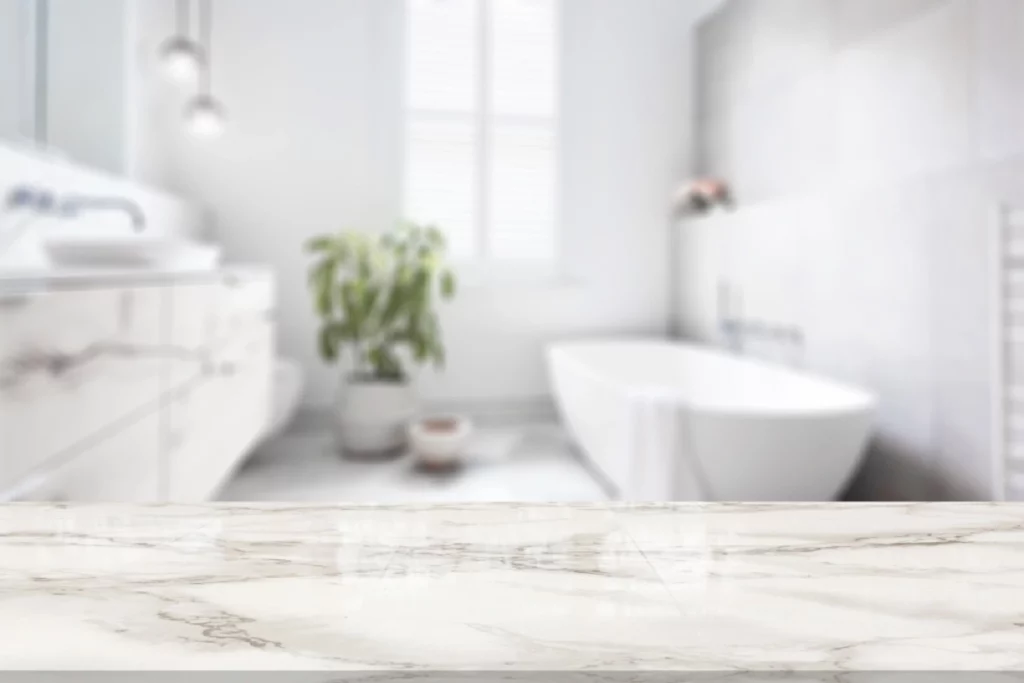
Countertops are a prominent feature in any bathroom and can significantly impact the overall cost of your remodel. Here are some key points to consider:
- Material Choice: Countertop materials vary widely in price. Laminate is the most budget-friendly option, while natural stone, like granite or marble, can be quite expensive. Quartz is a mid-range choice known for durability and aesthetics.
- Countertop Size: The size of your countertop, including additional surfaces like a makeup counter, will affect material costs.
- Edge Profile: Custom edge profiles or decorative edges will add to the expense.
- Sink Integration: If you choose an under-mount sink, it may require additional labor and materials for proper installation.
- Backsplash: Adding a matching backsplash can enhance the look but will increase costs.
Approximate Price Range
- Laminate: $15 – $40 per square foot
- Quartz: $50 – $120 per square foot
- Granite: $60 – $150 per square foot
- Marble: $75 – $250 per square foot
These price ranges include both material and installation costs. Remember that high-quality countertops can significantly elevate your bathroom’s appearance and resale value.
Cabinets and Shelving
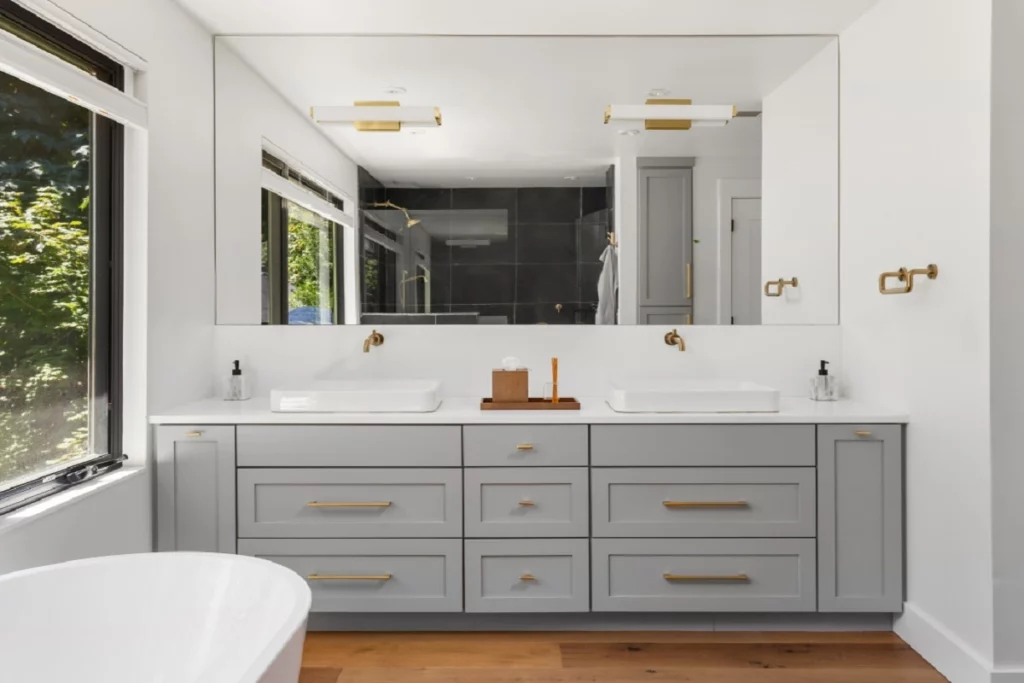
Cabinets and shelving are essential for storage and aesthetics in your bathroom remodel, and they can significantly impact the bathroom remodel cost. Here’s what you need to know about how they can affect the overall cost:
- Cabinet Material: The material you choose for your cabinets plays a major role in the bathroom remodel cost. Common options include particleboard, MDF (medium-density fiberboard), plywood, and solid wood. Solid wood is the most expensive but offers durability and a premium look.
- Cabinet Type: Stock cabinets are the most budget-friendly option, while semi-custom and custom cabinets offer more design flexibility but come at a higher cost.
- Cabinet Finish: Specialty finishes like glazes or distressing techniques may increase prices.
- Storage Features: Accessories like pull-out shelves, lazy Susans, and soft-close drawers can add to the bathroom remodeling cost but enhance functionality.
- Open Shelving: It can be a more economical choice if you opt for open shelving instead of closed cabinets.
- Installation: Labor costs for cabinet installation should also be factored into the average bathroom remodel cost.
Approximate Price Range
- Stock Cabinets: $60 – $200 per linear foot
- Semi-Custom Cabinets: $100 – $650 per linear foot
- Custom Cabinets: $500 – $1,200+ per linear foot
Remember that the number of cabinets and their size will impact the overall cost, as will any additional shelving units or built-in storage solutions. The choice between stock, semi-custom, and custom cabinets should align with your budget and design preferences.
Doors and Windows
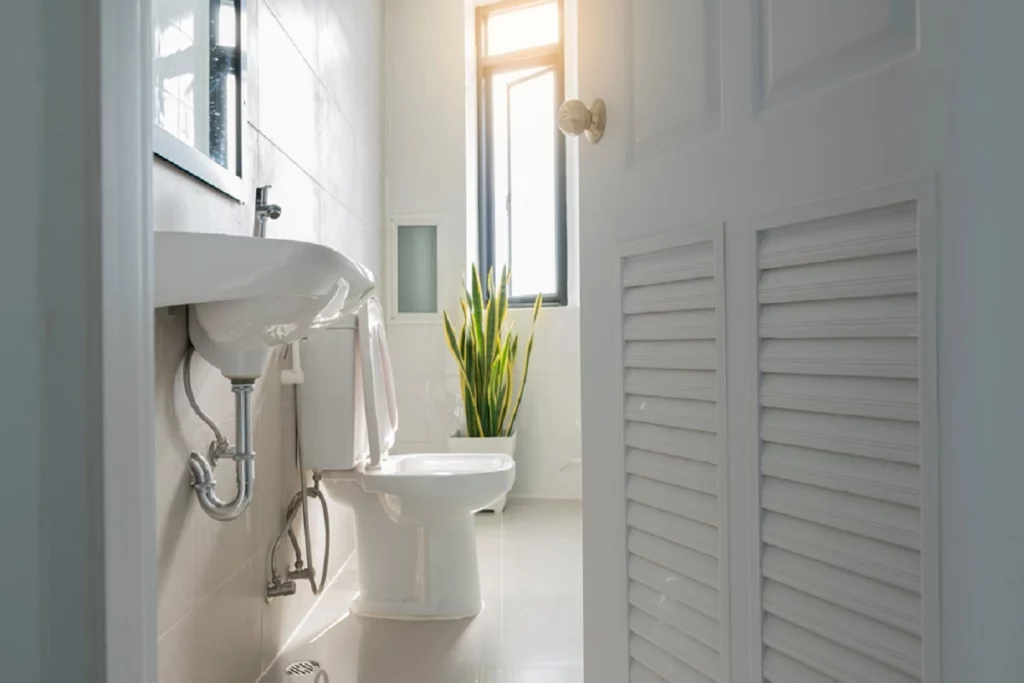
When planning your bathroom remodel, pay attention to the impact of doors and windows on the overall cost. Here’s a breakdown of how these elements influence your budget:
Doors
- Door Material: The type of door you choose will affect the bathroom remodel cost. Standard hollow-core doors are more budget-friendly, while solid wood or custom-designed doors can be more expensive but offer durability and aesthetics.
- Door Style: The style of the door, whether it’s a basic flush door or a decorative panel door, can impact the price.
- Size: Larger or double doors will cost more due to the increased materials and labor required for installation.
- Hardware: High-quality hardware, such as handles, knobs, and hinges, can add to the bathroom remodel cost.
Windows
- Window Type: The type of window you choose, such as a standard single-hung window or a custom-designed, energy-efficient window, can significantly affect the cost.
- Size: Larger windows or multiple windows will increase material costs and installation expenses.
- Frame Material: The material of the window frame, like vinyl, wood, or aluminum, plays a role in the cost.
- Energy Efficiency: Energy-efficient windows may have a higher upfront cost but can result in long-term savings on utility bills.
Approximate Price Range
- Interior Doors: $100 – $500 per door
- Exterior Doors: $500 – $2,500+ per door
- Windows: $200 – $1,500+ per window
Keep in mind that while investing in quality doors and windows can increase the bathroom remodeling cost, it can also enhance energy efficiency, aesthetics, and overall comfort in your remodeled bathroom. Make choices that align with your design preferences, budget, and long-term goals for your home.
Flooring
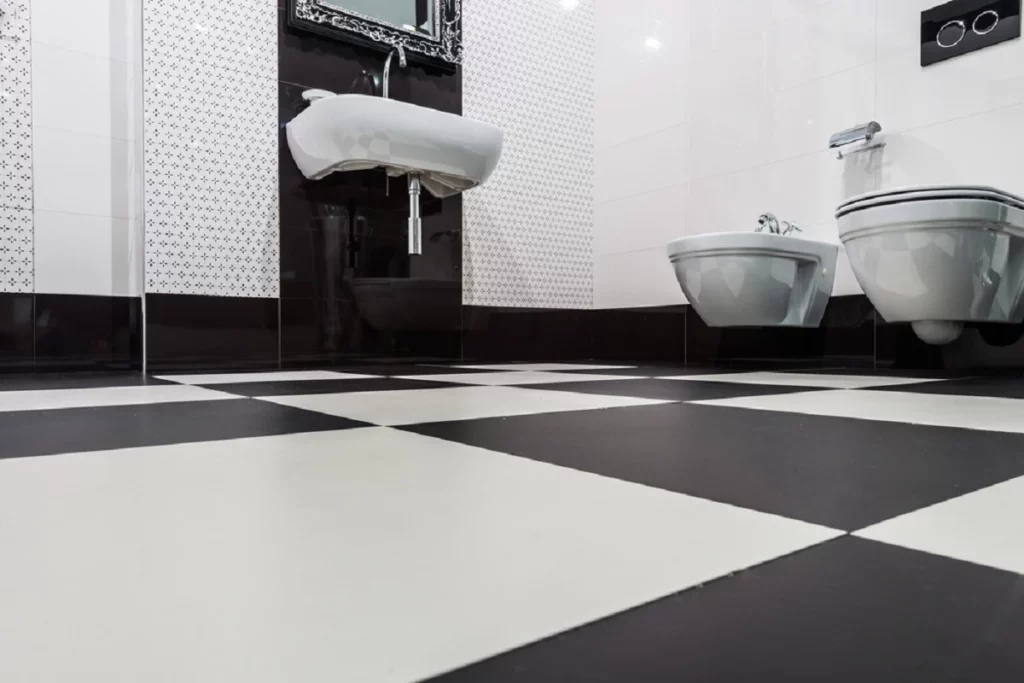
When considering a bathroom remodel, the choice of flooring is a significant factor that can influence the overall bathroom remodel cost. Here’s a breakdown of how flooring elements influence your budget:
1. Flooring Material: The type of flooring material you choose will considerably impact your bathroom remodel cost. Common options include ceramic tiles, porcelain tiles, natural stone (such as marble or granite), vinyl, laminate, and hardwood. Natural stone and hardwood tend to be more expensive, while vinyl and laminate are more budget-friendly.
2. Flooring Size: The square footage of your bathroom will determine how much flooring material you need. Larger bathrooms will naturally require more material, which affects the cost.
3. Installation Complexity: Intricate tile patterns or non-standard layouts can increase labor costs for installation.
4. Underlayment and Subfloor: If your existing subfloor or underlayment needs repair or replacement, this will add to the bathroom remodel cost.
5. Water Resistance: Bathrooms are prone to moisture, so choosing flooring materials that are water-resistant or waterproof is advisable. These materials may cost more upfront but can save you from potential water damage in the long run.
Approximate Price Range
- Ceramic Tiles: $1 – $15 per square foot
- Porcelain Tiles: $3 – $20 per square foot
- Natural Stone (Marble, Granite): $5 – $50 per square foot
- Vinyl: $1 – $7 per square foot
- Laminate: $1 – $5 per square foot
- Hardwood: $5 – $15 per square foot
Please note that these are approximate prices and can vary depending on factors like the brand, quality, and location. Additionally, labor costs for installation should be factored into your bathroom remodel budget. Your choice of flooring should align with both your budget and design preferences.
Lighting and Ventilation

Proper lighting sets the ambiance, while efficient ventilation keeps the space fresh and free from moisture-related issues. The elements of lighting and ventilation play a crucial role in functionality and the overall aesthetics of your revamped space. Here’s a breakdown of how lighting and ventilation elements influence your budget:
1. Lighting Fixtures: The choice of lighting fixtures can vary widely in price. Basic fixtures like recessed lighting or simple vanity lights are more budget-friendly, while designer or specialty fixtures can be more expensive.
2. Natural Lighting: Incorporating natural light sources, like larger windows or skylights, may require structural changes, impacting both design and cost.
3. Ventilation Systems: Proper bathroom ventilation is crucial for preventing moisture buildup and mold. Depending on your bathroom’s layout and existing ventilation, you may need to install or upgrade exhaust fans, which can add to the remodeling cost.
4. Electrical Work: If you’re adding new lighting or relocating fixtures, electrical work will be necessary and should be factored into your budget.
5. Energy Efficiency: Consider energy-efficient lighting options, like LED bulbs, which may have a higher upfront cost but can save on energy bills over time.
Approximate Price Range
- Basic Vanity Lighting: $50 – $200 per fixture
- Recessed Lighting: $20 – $100 per fixture
- Designer or Specialty Lighting: $200 – $1,000+ per fixture
- Skylight Installation: $500 – $3,000 (or more, depending on complexity)
- Exhaust Fan Installation: $100 – $400 per fan
Your choice of lighting and ventilation elements should align with your bathroom’s design goals and your budget. Additionally, consider energy-efficient options for long-term savings and eco-friendliness.
Sinks

Sinks are more than just functional fixtures in your bathroom; they are key design elements that can significantly influence the overall cost of your remodel. Here’s what you need to know about how sinks can impact your budget:
- Sink Material: The material of your sink plays a vital role in cost determination. Common materials include porcelain, ceramic, stainless steel, glass, stone, and copper. Porcelain and ceramic are budget-friendly options, while specialty materials like stone and glass can be quite expensive.
- Sink Type: The type of sink you choose also matters. Drop-in and under-mount sinks are typically more affordable, while vessel and wall-mounted sinks can be pricier due to their unique designs and installation requirements.
- Sink Size: Larger sinks, often preferred for their functionality, can add to your bathroom remodel cost due to their increased material requirements and potentially more complex installation.
- Sink Faucets: The style and finish of your faucet can range from basic to high-end, impacting the overall cost. Features like motion sensors or specialty finishes may come with a higher price tag.
- Number of Sinks: If you’re considering a double vanity or multiple sinks in one bathroom, be prepared for additional costs, both in terms of materials and labor.
- Installation: Sink installation involves plumbing work, which should be factored into the bathroom remodel cost. If your remodel requires relocating plumbing fixtures or creating new connections, it can drive up expenses.
Approximate Price Range
- Basic Sink: $50 – $300 per sink
- Mid-Range Sink: $300 – $700 per sink
- High-End Sink: $700 – $2,000+ per sink
Remember, the choice of sink should align with your design preferences, functional needs, and budget. Balancing these factors will ensure that your bathroom remodel project achieves the perfect blend of style and affordability.
Toilets
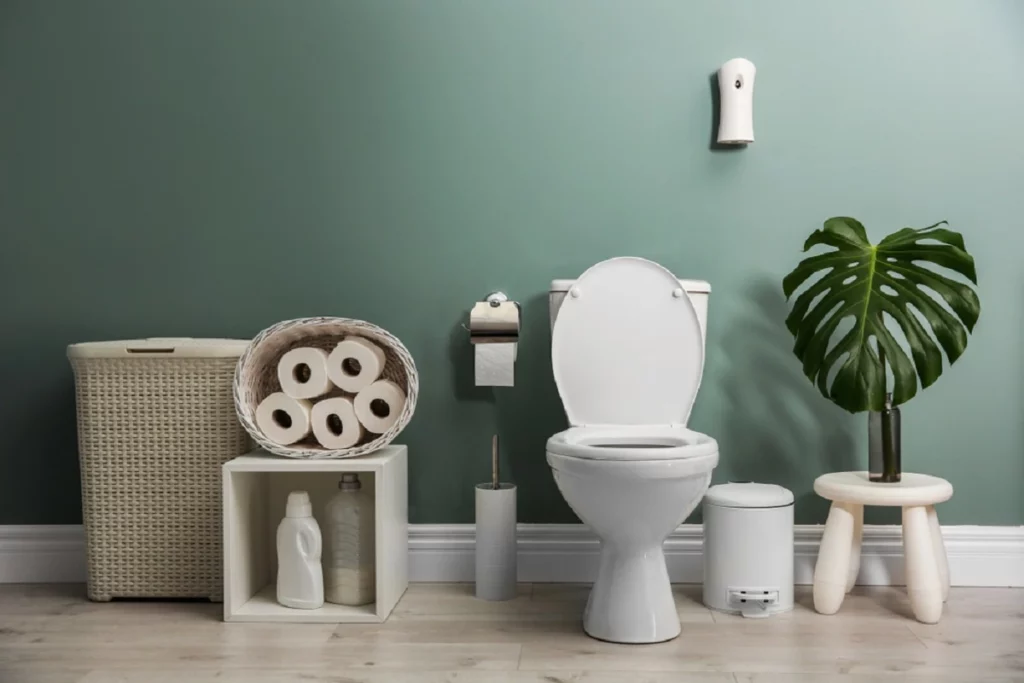
Toilets are a fundamental part of any bathroom remodel, and their choice can impact both the project’s functionality and overall cost. Here’s an overview of how toilets can affect your bathroom remodel expenses:
- Toilet Type: There are various toilet types available, each with different price points. Standard two-piece toilets are typically the most budget-friendly, while wall-mounted and one-piece toilets tend to be more expensive due to their unique designs and installation requirements.
- Toilet Material: Toilet bowls and tanks can be made from different materials, including porcelain, ceramic, and vitreous china. Porcelain and ceramic toilets are commonly used in budget-friendly remodels, while vitreous china offers a more premium, durable option.
- Toilet Features: Toilets can come with various features that add to their cost. These features include dual-flush mechanisms for water conservation, soft-close seats for convenience, and heated seats for added comfort.
- Installation: The cost of toilet installation should also be considered. If your remodel involves moving or replacing plumbing fixtures, this can contribute to the overall bathroom remodel cost.
Approximate Price Range
- Basic Toilet: $100 – $300 per toilet
- Mid-Range Toilet: $300 – $700 per toilet
- High-End Toilet: $700 – $2,000+ per toilet
Keep in mind that while budget-friendly options may save you money upfront, higher-end toilets often come with better water efficiency and durability. Your choice of toilet should align with your preferences for style, features, and long-term functionality while staying within your budget constraints.
Tubs and Showers
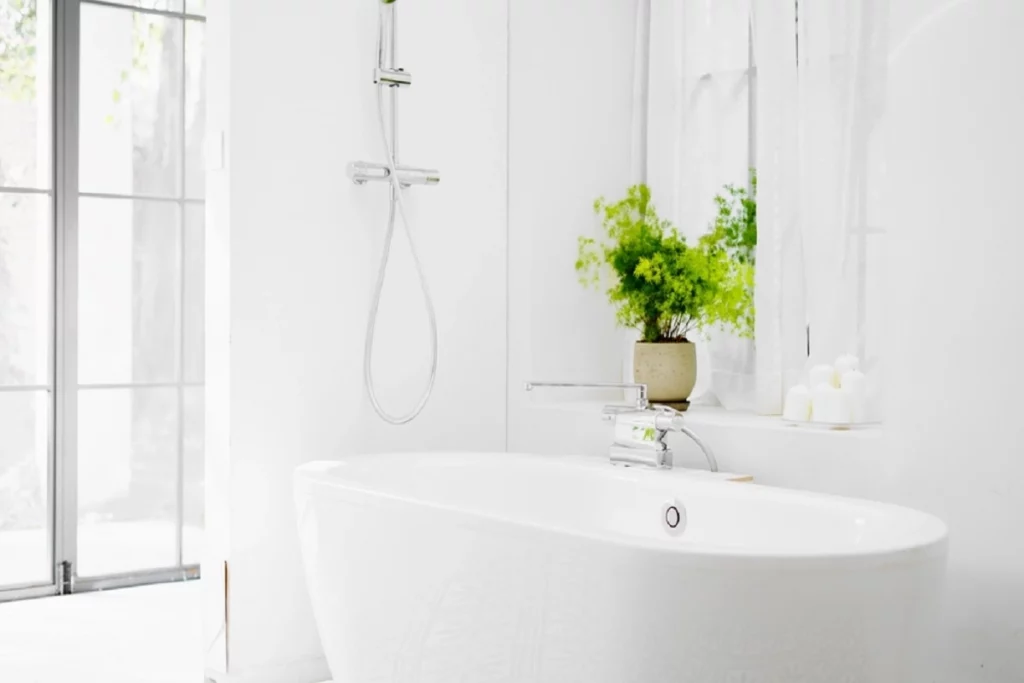
When planning a bathroom remodel, the choice of tubs and showers is crucial, not only for functionality but also for aesthetics. These elements can significantly influence your bathroom remodel cost. Here’s a breakdown of how they impact your budget:
1. Type of Tub or Shower:
- Standard Alcove Tub: These are the most common and budget-friendly options. They fit into a three-wall enclosure with a showerhead.
- Freestanding Tub: Freestanding tubs come in various designs, from vintage clawfoot tubs to modern sculptural pieces. They often cost more than alcove tubs.
- Walk-In Shower: A walk-in shower is a separate, open space with no tub. They offer accessibility and a spacious feel but may require more materials and labor.
- Luxury Spa Shower: These showers often feature multiple shower heads, body sprays, and high-end fixtures. They can significantly increase your remodel cost.
2. Materials:
- Tub and Shower Surround: The materials used for the tub or shower surround can vary widely in cost. Common options include fiberglass, acrylic, tile, stone, or solid surface materials like Corian. Natural stone and custom tile work tend to be more expensive.
3. Size and Layout:
- The size and layout of your tub or shower can impact costs. Larger or more complex designs require more materials and labor. For example, a separate shower and tub will cost more than a combined tub-shower unit.
4. Fixtures and Faucets:
- The choice of fixtures, including showerheads, faucets, and handles, can vary in price based on brand and design. High-end fixtures can significantly add to the overall cost.
5. Accessibility Features:
- If you’re considering features like a walk-in tub or accessible shower for mobility concerns, these specialized installations can be more expensive due to added features and construction requirements.
Approximate Price Range for Tubs and Showers
- Standard Alcove Tub: $400 – $1,200
- Freestanding Tub: $1,000 – $5,000+ (depending on material and style)
- Basic Shower: $800 – $2,500
- Custom Walk-in Shower: $3,000 – $10,000+ (depending on size and features)
- Tile or Stone Shower Surround: $800 – $5,000+
- High-End Fixtures: $100 – $1,000+ per fixture
It’s essential to consider your preferences, needs, and budget when choosing tubs and showers for your bathroom remodel. The complexity of the installation and the materials you select will significantly impact your bathroom remodel cost.
Faucets and Plumbing
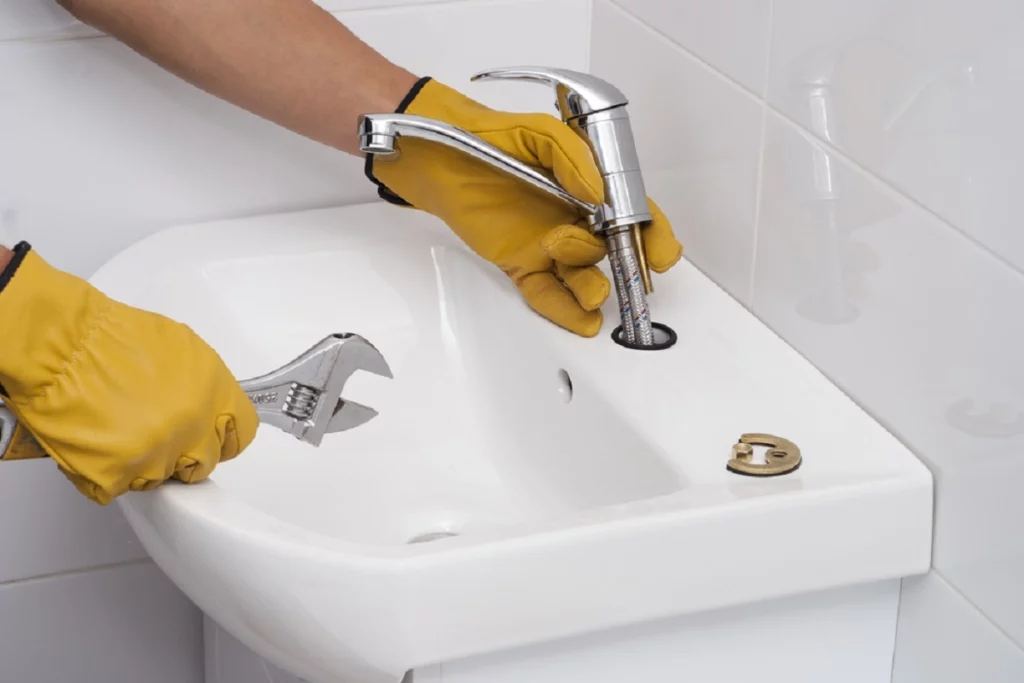
Faucets and plumbing fixtures are integral elements in enhancing a bathroom’s beauty. They offer a spectrum of styles and finishes, catering to diverse design preferences and enabling you to select fixtures that harmonize with your bathroom’s theme, whether modern, traditional, or vintage. These fixtures’ finish, material, and design serve as pivotal components in the bathroom’s visual appeal. Here’s how these elements influence your budget:
1. Faucet Types:
- Standard Faucets: These are the most common and budget-friendly options for bathroom sinks and tubs.
- Widespread Faucets: Widespread faucets have separate hot and cold handles and a spout. They offer a more traditional and elegant look but can be more expensive.
- Wall-Mounted Faucets: These faucets are installed on the wall above the sink or tub. They provide a modern and clean look but may require additional plumbing work.
- High-Arch Faucets: High-arch faucets, often called gooseneck faucets, provide more space for washing hands or filling tall containers. They come in various styles and price ranges.
2. Finish and Material:
- Faucets come in a range of finishes, including chrome, brushed nickel, oil-rubbed bronze, and more. High-end finishes can add to the cost.
3. Plumbing Fixtures:
- Beyond faucets, other plumbing fixtures like shower heads, tub fillers, and toilet mechanisms can vary in price based on quality and style.
4. Installation Complexity:
- If your remodel involves relocating plumbing lines or adding new fixtures, this can increase the labor costs associated with plumbing installation.
Approximate Price Range for Faucets and Plumbing
- Standard Sink Faucet: $50 – $200 per faucet
- Widespread Sink Faucet: $150 – $400+ per faucet
- Wall-Mounted Sink Faucet: $200 – $500+ per faucet
- Tub Faucet: $100 – $300 per faucet
- Showerhead: $20 – $200 per shower head
- Shower Valve and Trim Kit: $150 – $500+ per valve and trim Kit
- Toilet Mechanism (flush valve, fill valve, etc.): $10 – $100+
Remember the number of faucets and plumbing fixtures you choose and their style and material will impact your bathroom remodeling cost. When making these selections, it’s essential to strike a balance between functionality, aesthetics, and your budget.
Paint or Wallpaper
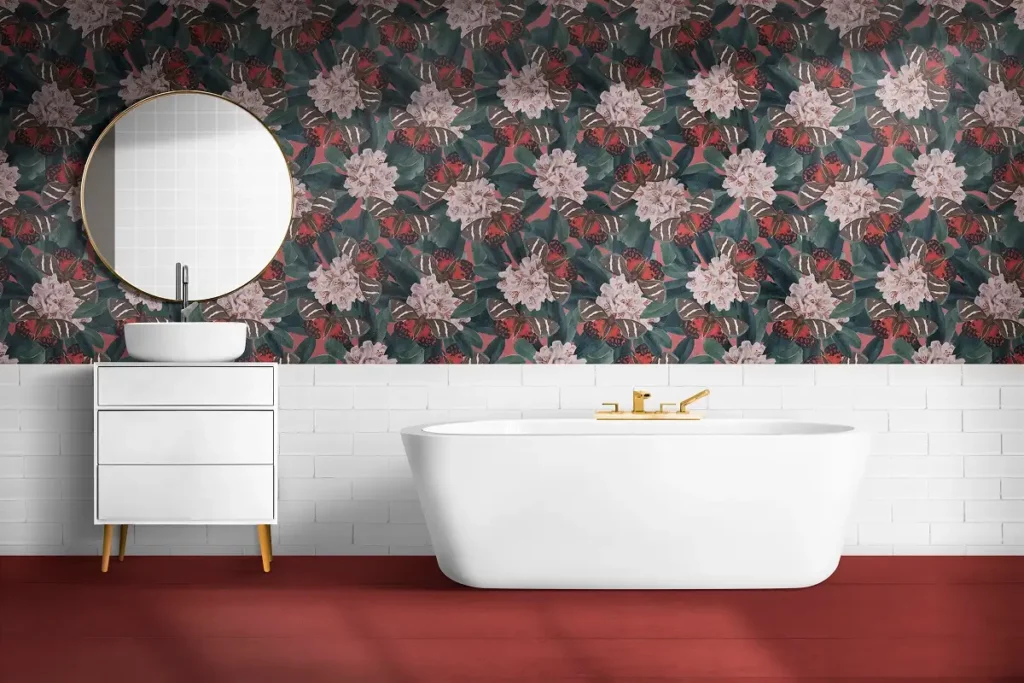
The selection of paint or wallpaper for your bathroom walls holds the power to transform the space’s aesthetic appeal. Vibrant and carefully chosen paint colors can infuse energy and personality into the bathroom, creating a sense of vibrancy or calm, depending on your color palette. On the other hand, wallpapers offer the opportunity to introduce captivating patterns, textures, and even scenic landscapes, adding depth and visual interest to the room. The choice between paint and wallpaper for your bathroom walls can significantly affect your bathroom remodel cost:
1. Material Selection: The type of paint or wallpaper material you select will play a substantial role in your bathroom remodel cost. High-quality paint brands and designer wallpapers are more expensive, while basic paint and standard wallpapers are budget-friendly options.
2. Surface Preparation: If your bathroom walls require extensive preparation, such as repairs, priming, or removal of existing wallpaper, this can add to the labor costs.
3. Application Complexity: Complex patterns or designs for wallpaper may require more meticulous installation, affecting labor costs. Similarly, if you opt for decorative painting techniques like faux finishes, this can increase both material and labor expenses.
4. Wallpaper Pattern: The intricacy and design of the wallpaper pattern can impact the cost. Custom or designer wallpapers typically come at a premium.
5. Wall Size: The size of your bathroom walls will determine the amount of paint or wallpaper needed. Larger bathrooms will require more material, which can affect your budget.
Approximate Price Range
- Paint: $20 – $50 per gallon
- Wallpaper: $30 – $150+ per roll (standard size)
Please note that these are rough estimates and can vary based on factors like brand, quality, and location. Labor costs for application should also be considered when budgeting for your bathroom remodel. Your choice between paint and wallpaper should align with your design vision and budget constraints.
Labor
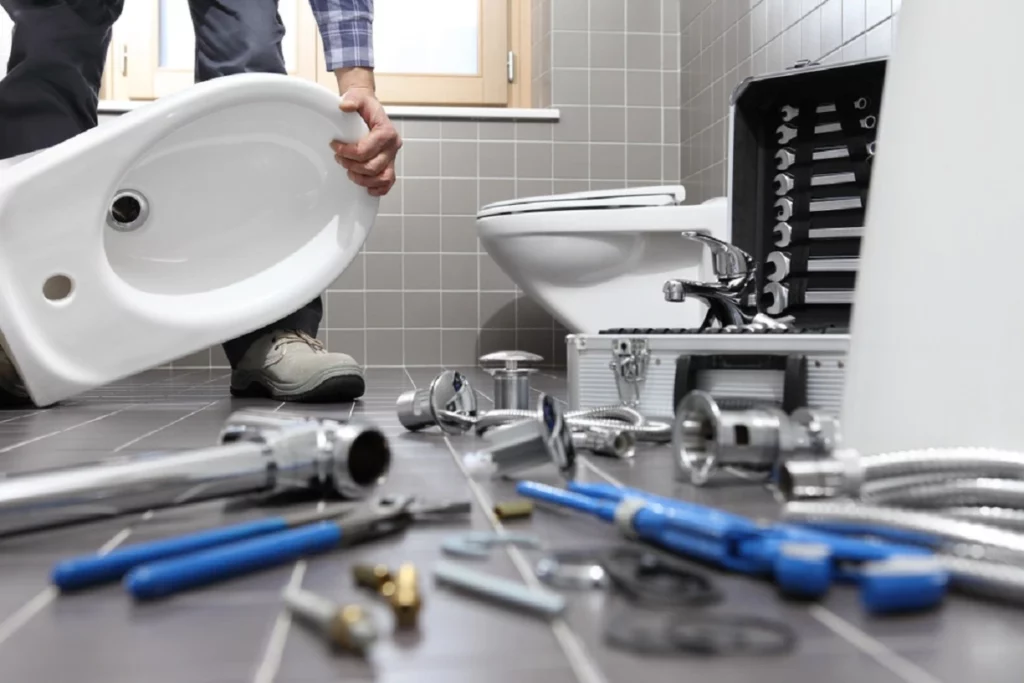
The labor component of your bathroom remodels a crucial factor that can significantly impact the project’s overall cost and quality. Skilled labor is essential for executing the renovation plans effectively and ensuring that every detail is attended to with precision. Experienced professionals, such as plumbers, electricians, carpenters, and tile installers, are necessary to bring your vision to life. Labor is a pivotal factor that can significantly influence the cost of your bathroom remodel. Here are some key points to understand how labor plays a role in your budget:
- Skilled Tradespeople: Hiring skilled professionals such as plumbers, electricians, carpenters, and tile installers is crucial for ensuring that the renovation is executed accurately. Their expertise ensures that plumbing and electrical work is safe and compliant with local codes while also guaranteeing the structural integrity of the remodel.
- Complexity of Work: The complexity of the remodel can impact labor costs. Intricate tile patterns, non-standard layouts, or customized features may require more labor hours, potentially increasing the overall cost.
- Demolition and Removal: Labor is needed to remove old fixtures, tiles, and structures. This project phase requires careful deconstruction and disposal, which adds to the labor cost.
- Project Management: General contractors or project managers oversee the entire remodel, coordinating various tradespeople, schedules, and inspections. Their role ensures the project progresses smoothly but also adds to the labor costs.
Approximate Labor Cost Range
Labor costs can vary widely based on the scope and complexity of your bathroom remodel. On average, you can expect labor costs to account for about 40% to 60% of your total bathroom remodel budget. To provide a rough estimate, here’s a range for labor costs based on the type of work:
- Basic Bathroom Remodel: $3,000 – $7,000 This includes minor cosmetic updates like replacing fixtures, painting, and minor tile work.
- Mid-Range Bathroom Remodel: $8,000 – $15,000 This includes more extensive work such as replacing fixtures, tiles, vanity, and adding custom features.
- High-End Bathroom Remodel: $15,000+ For a luxurious remodel with high-quality materials and custom features, labor costs can increase significantly.
Please note that these are approximate ranges and labor costs can vary based on your location, the project’s complexity, and the rates charged by individual tradespeople or contractors. It’s essential to obtain detailed quotes from professionals to understand the labor costs for your bathroom remodel.
Additional Bathroom Remodeling Costs for Considerations
Beyond the major factors we’ve discussed, there are several additional bathroom remodeling costs to consider when planning your project:
- Permits and Inspections: Depending on the scope of your remodel, you may need permits for structural, plumbing, or electrical work. These permits often come with fees, and inspections may also be required at various project stages.
- Design and Planning: If you’re working with an architect or designer to create custom plans, their fees will add to the overall cost. However, their expertise can help you achieve the desired look and functionality.
- Structural Changes: If your remodel involves moving walls, windows, or doors, you’ll incur additional costs for structural alterations and potentially reinforcing the structure.
- Plumbing and Electrical Upgrades: If your remodel includes relocating fixtures or upgrading plumbing and electrical systems to meet current codes, this will increase costs.
- Accessories and Fixtures: Towel bars, mirrors, showerheads, and other bathroom accessories can add to the cost. High-end fixtures and finishes will also increase your expenses.
- Storage and Cabinetry: Consider the cost of storage solutions, such as cabinets, shelving, and custom-built storage units, as they can vary widely in price.
- Ventilation: Proper ventilation is essential to prevent moisture issues. Installing or upgrading exhaust fans or ventilation systems may be necessary.
- Safety Features: If you plan to age in place or want added safety, consider features like grab bars, non-slip flooring, or a curbless shower. These enhancements come with additional costs.
- Waste Removal: Proper disposal of construction debris and waste is a cost that’s often overlooked. Renting a dumpster or hiring a waste removal service will incur charges.
- Contingency Budget: It’s wise to set aside a contingency fund of around 10% of your total budget to cover unexpected expenses or changes in project scope.
- Designer or Architectural Fees: If you’re working with a designer or architect, their fees should be factored into the budget.
- Financing Costs: If you’re financing your remodel with a loan or credit, consider the interest and fees associated with borrowing.
- Accessibility Modifications: If your remodel aims to make the bathroom more accessible for individuals with disabilities or aging homeowners, costs for features like walk-in tubs or wider doorways should be considered.
- Storage Solutions: Adding storage solutions like built-in shelves, linen closets, or vanity cabinets can impact the overall cost.
How to Save Money on Bathroom Remodel Cost?

Saving money on your bathroom remodel cost is possible with some strategic planning and decision-making. Here are several tips to help you stay within budget:
- Start by determining how much you will spend on your bathroom remodel. Be realistic about what you can afford, considering both your savings and financing options.
- Identify your essential needs for the bathroom and prioritize those over wants. Focus on necessary improvements first, and if your budget allows, add luxury features later.
- Moving plumbing fixtures is one of the most significant costs in a bathroom remodel. Try to keep the existing layout to save on plumbing and labor expenses.
- If your current fixtures are in good condition, consider keeping them and only replacing worn-out or outdated elements. Refinishing or reglazing can also breathe new life into old fixtures.
- Look for sales, discounts, and promotions when purchasing tiles, flooring, and fixtures. Buying in bulk or choosing slightly imperfect items can yield significant savings.
- Explore cost-effective alternatives to high-end materials. For example, choose porcelain tiles that mimic the look of natural stone or opt for laminate countertops instead of granite.
- Replacing a bathtub or shower can be expensive due to plumbing work. If they are in good condition, consider refinishing or retiling to refresh their appearance.
- Custom or oversized fixtures often come with a premium price. Choosing standard-sized items can save money on both the fixtures themselves and installation.
- Instead of expanding the bathroom’s footprint, maximize the use of existing space by optimizing storage solutions and layouts.
- Make sure to make changes or additions mid-project, as these can result in costly delays and alterations to your budget.
- Seek estimates from multiple contractors and suppliers to ensure you’re getting the best value for your investment.
- Invest in energy-efficient fixtures and lighting. While this may have a higher upfront cost, it can lead to long-term savings on utility bills.
- Make durable choices that will stand the test of time, reducing the need for frequent repairs and replacements.
Hiring a Professional for Your Bathroom Remodel: Is It Worth It?

When contemplating a bathroom remodel, deciding to enlist professional help or take the DIY route can be pivotal. The key question is, is it worth hiring a professional for your bathroom remodel?
Professionals, such as general contractors or specialized bathroom remodel services, come equipped with expertise filed through years of experience. They deeply understand the complexities of bathroom renovations, from plumbing intricacies to intricate tiling work.
Hiring a professional can translate to peace of mind, knowing your project will be executed efficiently and in compliance with local building codes.



